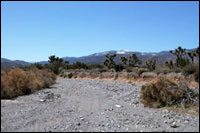It’s close to a nightmare scenario and at the very least it’s a very bad dream.” That’s how Jim Murphy, wetlands and water resources counsel at the National Wildlife Federation*, characterized a draft-stage rewrite of a Clean Water Act rule, which was leaked to The Los Angeles Times by a top government official earlier this month. The rewrite has been in the works since January 2003, when then-EPA Administrator Christie Whitman announced the administration’s intention to change the way the act is implemented, potentially removing protections from some 20 million acres, or 20 percent of areas now classified as wetlands in the continental U.S.

Wetland of plenty.
Photo: EPA.
The current draft, Murphy said, could affect an area even more vast. The draft revisions would redefine the scope of the Clean Water Act to exclude “ephemeral washes or streams” created by rain and snowmelt rather than groundwater; streams that flow for less than six months out of the year; and many wetlands defined as “isolated” or “non-navigable.”
The very terms used to define these areas — isolated, ephemeral — suggest a fundamental ignorance (or dismissal) of how water systems work, according to environmental advocates. Betsy Otto, senior director of the watersheds program at the environmental organization American Rivers, said that more than three decades of government policy has been based on scientific research indicating that all wetlands are either biologically or hydrologically connected to larger waterways. Even the smallest and most isolated of wetlands can provide spawning grounds for fish and fowl that are critical to the ecosystem as whole, and these wetlands act as crucial filters that absorb pollutants before they can drain into bigger waterways.
EPA spokesperson Cynthia Bergman stressed that no decisions have been made on whether or how to proceed on this issue. She said that the draft of the rule did not come from an EPA official, and that no agency officials want to discuss the rule change unless it becomes an official proposal.
In January, the EPA defended its initial draft revision as an extension of the Supreme Court’s so-called SWANCC decision (pronounced “swank”), which permitted the Solid Waste Agency of Northern Cook County, which manages waste for 23 suburban Chicago towns, to transform an isolated wetland into a garbage dump. The permit was originally denied to the consortium because the wetland was used by migratory birds, but the high court ruled that the birds’ use of the area was not sufficient grounds for denying development rights.

Protections could dry up for desert streambeds.
Photo: USGS.
“It was one thing to deny wetland protection based on the presence of migratory birds alone,” said Otto. But now, she argued, the EPA is trying to steer a thousand-foot tanker through the Supreme Court’s canoe-sized loophole. According to Murphy of the NWF, upwards of 90 percent of streams in the Southwest are intermittent due to the arid climate and would not fall under the purview of the revised Clean Water Act rule. Areas like San Francisco’s wetlands that are diked and cut off from the bay could be drained and junked by developers. Intermittent headwater streams, which are often important spawning grounds for salmon, might suffer under this rule change as well — including those feeding the Klamath, Eel, and Salmon rivers in the Northwest.
Interestingly, it’s the duck hunters and anglers — traditionally Republican Bush supporters — who are waging the strongest resistance to the potential rule change. “We were shocked when we saw this draft revision of the rule. It was pretty much a worst-case scenario,” said Scott Yaich of Ducks Unlimited. “It would represent a radical change from the kind of wetlands protection we’ve seen in the last 30 years. And it would spell doomsday for a lot of ducks.” Happily, it seems the hunt-and-fish crowd is less committed to protecting their politicians than their prey.
The Man with the Golden Lawn Mower
Meanwhile, Sen. Kit Bond (R-Mo.) and the nation’s largest small-engine manufacturer, Briggs and Stratton, are taking aim at a different target: states’ rights. Briggs and Stratton operates two large factories in Missouri; no surprise, then, that Bond led the campaign to block an effort by California to enact clean-air standards for lawn and garden equipment powered by small engines.

Bond, Kit Bond.
Photo: U.S. Senate.
Bond got his way: On Wednesday last week, the Senate voted to insert an amendment into an appropriations bill that would not only ditch California’s proposal but relax what little regulation already exists for small engines. Bond’s success marked yet another sabotaging of California’s attempts to cut smog to safer levels by 2010. In October 2002, a state effort to enact new zero-emission-vehicle regulations was thwarted by the Bush administration. Now, with several of its major cities regularly violating clean-air standards, California is running low on solutions.
While emissions of lawn mowers and weed whackers might seem insignificant, those buzzing contraptions are in fact heavy polluters: Mowing a lawn for one hour produces as much pollution as driving an average car for 13 hours. By requiring that new small engines be equipped with catalytic converters, the California Air Resources Board would have eliminated as much pollution as if a whopping 1.8 million cars were taken off the road. Meanwhile, Bond’s amendment would be the equivalent of adding 700,000 cars to California’s roads.
Word inside the Beltway is that some governors are calling on congressional leaders to terminate Bond’s amendment, including the Terminator himself, California Gov. Arnold Schwarzenegger (R). Florida Gov. Jeb Bush (R), despite party ties, is also putting in at least one call — to Florida Rep. Bill Young (R) — to protest.
Frank O’Donnell, executive director of the Clean Air Trust, calls the campaign to kill the CARB regulations “one of the most shameless Beltway lobbying blitzes in recent memory.” From July 2002 through June 2003, Briggs and Stratton spent $340,000 on D.C. lobbyists.

How low can you mow?
No Briggs and Stratton officials or spokespeople were available for comment, but according to the company’s website, the California rule would have cost 22,000 manufacturing jobs in 23 states. Speaking on the Senate floor, Bond cited these numbers — but failed to mention that the study that generated them was paid for by Briggs and Stratton and was based on an earlier California proposal that was discarded in September. The senator also failed to mention that an analysis by CARB of the Briggs and Stratton study found that it had substantially inflated the cost estimate for the technological changes, leading to an inflation in the alleged impact on jobs. Nor did Bond note that the company reported (in material filed with the Securities and Exchange Commission) that it did not believe the CARB requirements would have “a material effect on [the company’s] financial condition” because the California market represents a relatively small share of its business.
Bond also argued that the California rule change would pose a fire hazard, claiming that smaller catalytic converters were more prone to catching fire than the larger ones found in cars. Yet he failed to mention that the California Fire Chiefs Association wrote a letter to Sen. Dianne Feinstein, a Golden State Democrat and a strong advocate of the CARB standards, throwing its support behind the standards and opposing any effort to restrict the right of states to clean up the air. “We support the regulation moving forward,” wrote association President William McCammon on Nov. 11. “I believe that working closely with CARB we will find a solution that will provide a high degree of fire safety while maintaining CARB’s goals for air quality.”
What makes Bond’s lobbying blitz even more suspicious, according to O’Donnell, is that his right-hand man in the effort, John Stoody, is an employee of the U.S. EPA. In a “Dear Colleague” letter sent earlier this week, Bond suggested that other senators “contact me, or have your staff contact John Stoody, with any questions.”
Seems, then, that the Bush administration has been a key player behind the scenes on this effort to roll back protections. In other words, have your staff contact John Stoody with any questions.
Al Gore: Relief Pitcher
If you have questions related to waterless urinals, however, the go-to guy is none other than former Vice President Al Gore. Long a champion of high-tech environmental solutions, Gore is now flush with excitement over a new kind of clean technology. In exchange for stock options (but no direct payment), Gore has agreed to serve on the advisory board of Falcon Waterfree Technologies and promote its flagship product: a urinal that traps waste in a replaceable cartridge and eliminates odor with a liquid sealant.

The urinal of tomorrow — today.
This may seem like a strange endorsement for a man who is nursing a somewhat beleaguered public image; hawking urinals has, if possible, even less sex appeal than promoting Viagra. But it could have a fat payoff, according to Joel Makower, cofounder of Clean Edge, Inc., a consulting group that works with industry on clean technologies. Makower said waterless urinal sales are poised for dramatic growth; currently a teensy $4.5 million industry, the green urinal biz could become a $90 million industry in the next few decades if the water-free technology becomes the industry standard. And the long-term need seems all but guaranteed: The United Nations predicts that by 2026, the world demand for water will outstrip the world’s supply by 56 percent.
With this in mind, Gore has advised Falcon to couch its advertising in terms that will appeal to politically active urinators. “We’re taking his advice,” said Jay Troger, president of the company’s U.S. division. “Our plan is to try and get major environmental groups to put our product on their agenda, including Sierra Club, Environmental Defense, Save the Bay. Our message is: This is yet another major advance in clean technology, and it’s critical for the well-being of the planet.”
Indeed. In a typical commercial installation, each Falcon urinal conserves an average of 40,000 gallons of freshwater per year. Each installation also saves significant water and plumbing costs, so it’s not surprising that these urinals are appearing at more and more high-profile locations, including Disney World, the Taj Mahal, and the IBM research headquarters in Raleigh-Durham, N.C. Not to mention sports arenas: The Florida Marlins’ Pro Player Baseball Stadium boasts 228 Falcon Waterfree urinals. With some 65,000 fans in attendance at Pro Player during each game of the World Series this year, the savings were easily 100,000 gallons per game. Not bad in an area of the country that recently had water-usage restrictions brought on by a three-year drought.
Understandably eager to celebrate this accomplishment, Falcon Waterfree Technologies issued the following press release: “Every half-inning there is a rush of fans heading for the restrooms,” it read. “What these fans may not realize is that they are relieving Miami-area water demands while relieving themselves.” For Gore’s sake, let’s hope the company relieves the PR person who came up with this line — before he or she calls on the former veep to do a product demonstration.
*[Correction, 20 Nov 2003: This column originally stated that Jim Murphy is director of wetlands policy at the National Wildlife Federation. In fact, he is wetlands and water resources counsel at NWF.]


